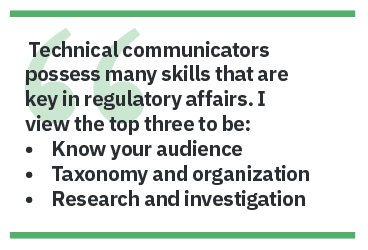By Melissa H. Sanchez | STC Member
Willingness to take on new opportunities can guide your career path
My Career Journey
My background as a technical communicator combined with my experience in biotech led me to a new and interesting role in Regulatory Affairs.
Though my career has been based in the biotechnology industry, there have been many changes through the years. After graduating from college with a BS in biomedical science, my goals were to find work in a laboratory and one day cure cancer. By my early 20s, I was tired of being a poor research assistant, and so I moved into an industry role at a biotech manufacturing company in their quality control department. By my mid-20s, I was surprised to find I no longer enjoyed working in the laboratory. I was burnt out working on manufacturing schedules and backorder reports and was also expecting my first child. During this time, a pivotal manager entered my life. She was the first manager who told me that it was her job to get me to the next level — whatever that might be. She helped me transition from bench work to a technical writing role. Later when my pregnancy had an unexpected end, she convinced the company to allow me to work a hybrid work schedule while I pieced myself back together. (This was a hard sell since only sales reps worked remotely at the time.)
As a technical writer, I moved into many different teams/departments involved with manufacturing and process improvement over three company mergers and acquisitions. As the lone technical writer, there was not much career growth. I stayed in this role much longer than I should have, but like many parents, I valued the flexibility of my hybrid work schedule while my kids were young. During this time, I joined the Society for Technical Communication (STC) and was able to take various courses to help build up my technical writing toolbox.
Forced Out of My Comfort Zone
My first experience being laid off happened in my late 30s. This was the kick-in-the-pants for me to start focusing on myself and on what I wanted in my career. Three months later, I was hired at a start-up pharmaceutical company as a documentation specialist. Here my experience in technical communication was viewed as an asset; my initial tasks were updating and streamlining internal procedures and managing records, but my responsibilities quickly expanded because of my organization skills. I was promoted to a project manager position and was not only involved with updating technical content (e.g., technical reports, standard operating procedures, other records) and the regulatory documents for drug candidates (e.g., IND, IMPD) but also working on special projects. Unfortunately, the drug did not make it, the company closed, and I was laid off again.
During my short year and a half in the pharmaceutical industry, I learned from my first layoff and spent time building my professional network. Networking was not always those uncomfortable evenings making forced conversation. I approached it by staying in touch, meeting with old coworkers for lunch, and catching up. Since I nurtured my network, I found a new position much quicker than my first layoff. In fact, I had two job offers to consider at the same time.
Now in my early 40s, I currently work with an in vitro diagnostic company. Initially, I was hired to help with technical content with the research and development (R&D) teams but it quickly changed into creation, revision, and management of product instructions (e.g., IFUs, software user guides). Again, I was the only technical writer but the expanded scope of work allowed me to reach out cross-functionally at the company. I also volunteered to work on an organization system for new product development using SharePoint which gave me more company exposure. These projects increased my interactions with the Regulatory Affairs department.
After helping the regulatory affairs department with some documents for a U.S. Food and Drug Administration (FDA) De Novo submission — a process for classifying novel medical devices — the head of the department approached me about joining her team. She was searching for someone to help not only with submissions and other regulatory tasks but also implement processes and organizational systems for regulatory documentation. My initial thought was, “Ick, all those rules!” After thinking about it further, I knew I was currently doing a lot of work with regulatory affairs. I enjoyed the hiring manager and she appreciated my work. I also watched her promote her hard-working direct reports and knew she would do the same for me, so I took the leap.
Technical Communications is an Asset in Regulatory Affairs
Technical communicators possess many skills that are key in regulatory affairs. I view the top three to be:
- Know your audience
- Taxonomy and organization
- Research and investigation
Know your audience
Knowing your audience and understanding the ultimate end goal of a project is just as important in regulatory as with any technical writing project. It is important to understand where a product will be sold in order to put together submissions based on the regulatory requirements for that market. Understanding the market requirements is key since a particular product may get clearance in some markets but not in others — the intended use of the product is a major factor. For example, a diagnostic genetic test may have a carrier screening claim that may impact the reproductive choice of the patient. The test may not receive market clearance due to the religious implications in some countries. A business may decide to not sell in that market or a similar product could be created for that particular market with the carrier screening claim removed.
Taxonomy and organization
 Classification and organization of documents and how they will be viewed and accessed is another skill that technical communicators possess. This skill gives our audience (i.e., the regulatory agencies) the information they need in an easy-to-digest format. Many regulatory agencies have guidance documents for submissions. Finding and following these documents will help the agency navigate your submission. For example, the FDA Center for Devices and Radiological Health (CDRH) uses an electronic submission process called the eCopy Program. They have published a guidance document that includes recommendations for volume and non-volume-based file structures, bookmarks, hyperlinks, preferred fonts, etc. The FDA is telling us how to help them — let’s give it to them!
Classification and organization of documents and how they will be viewed and accessed is another skill that technical communicators possess. This skill gives our audience (i.e., the regulatory agencies) the information they need in an easy-to-digest format. Many regulatory agencies have guidance documents for submissions. Finding and following these documents will help the agency navigate your submission. For example, the FDA Center for Devices and Radiological Health (CDRH) uses an electronic submission process called the eCopy Program. They have published a guidance document that includes recommendations for volume and non-volume-based file structures, bookmarks, hyperlinks, preferred fonts, etc. The FDA is telling us how to help them — let’s give it to them!
When creating documents or a submission where guidance cannot be found, my general submission recommendations are:
- Provide a map; include a table of contents and/or document list
- Be clear and consistent with terms and document formatting
- Provide the definitions of terms used
- Link anything possible (tables, figures, websites, etc.)
- Make sure the document is searchable with standard find features or by optical character recognition (OCR)
Also, during my time with regulatory affairs, I have streamlined and maintained the department’s electronic file storage process for submissions and created a system to manage document requests from distributors. For both projects, I took into account the needs/requirements of the department and the tools available to me.
For the submission file storage project, I addressed the company’s requirement of maintaining hard copies and electronic copies of submissions, as well as the need to be able to access the documentation quickly. A process was in place for hard copy file storage, but the electronic submission storage needed fine-tuning. SharePoint repositories were utilized, and the information was organized by country, agency (or the in-country representative), and date. During the pandemic, this system was particularly helpful for remote audits. It allowed us to retrieve electronic files quickly for our auditors to review. There was no additional step of scanning or the need for making physical copies.
The distributor document requests project was related to organizing product registrations in various countries. We used OneNote for these requests. In OneNote, I organized tasks for the regulatory affairs and legal teams. Both teams were able to update their tasks and would have visibility to the status of the various product registrations.
Research and investigation
Channeling your inner Sherlock Holmes to find the needed information for a project is not new for technical communicators. This skill is valuable and is used daily in regulatory. Whether it is finding the correct regulation or guidance for the product or finding the correct subject matter expert to provide an answer, you are always on the hunt for information.
In May 2022, a new regulation will come in force in the EU for in vitro diagnostic products, the In Vitro Diagnostic Regulation (IVDR). For this project we have performed a gap assessment is between the regulation and the company’s quality management system (QMS). This took lots of research and interviewing of the R&D and quality assurance departments to determine if the QMS documents align with the regulation. Assessments like this are done often, so it’s essential to have research and investigation skills in your tool belt.
Suggested Next Steps
This field is constantly changing. If you are interested in regulatory affairs, you must be willing to learn as new regulations and requirements are put in force often. To stay current with the regulatory environment and changes, I suggest the following:
- Join professional organizations like the Regulatory Affairs Professional Society (RAPS) or Drug Information Association (DIA); both have very informative newsletters.
- Learn and stay current on industry standards or other related programs (e.g., ISO 13485, ISO 14971, IEC 62304, or MDSAP).
- Utilize social media and follow or subscribe to regulatory-related blogs, newsletters, and find webinars/training seminars (Note: most items listed are related to medical devices).
- Follow regulatory agencies and consultants on LinkedIn to get the most up-to-date information.
If you are at a company with a regulatory affairs department and are ready to take your first steps into this area, I suggest you chat with some people in that department and express your interest in working on projects with them. I also suggest networking. Attending biotech-related networking events and meeting regulatory affairs professionals for coffee or lunch to discuss their projects are excellent ways to start your move. Networking is not only valuable for career transitions, but also for finding a new job should you need it. You never know what could happen in the job market.
Skills used by technical communicators are an asset in regulatory affairs. Our ability to understand our audience and end goal, our use of organization and classification of information, and our investigation skills make us a great fit in this industry. In my experience, being open to new opportunities and networking led me to regulatory affairs and grow my career in ways I did not imagine. During my short time in regulatory affairs, I have received a promotion for my work on regulatory projects during the middle of the pandemic. My technical communication skills, my willingness to continually learn, and saying yes to new opportunities have moved my career forward.

MELISSA H. SANCHEZ (melissahsanchez@gmail.com) is a biotechnology and technical communications professional experienced in biotech manufacturing, pharmaceutical, and diagnostic industries. Currently, she helps solve regulatory problems to ensure safe and effective medical products reach patients who need them worldwide. Connect with Melissa on LinkedIn (https://www.linkedin.com/in/melissahsanchez).


